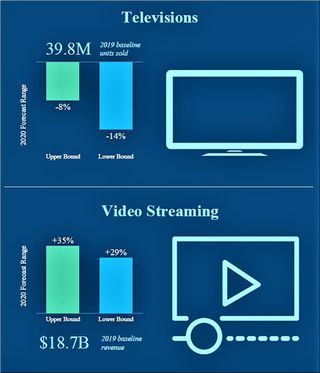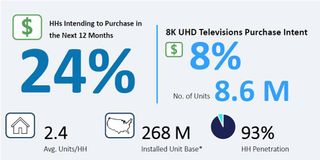Video Streaming Is Bright Spot in CTA Post-COVID Outlook
Two updated forecasts from the Consumer Technology Association paint a mixed outlook for digital media consumption in the coming year. Collectively, the reports offer perspectives for both the hardware and the content that Americans will embrace as the entertainment and work-at-home worlds recalibrate their positions following the current financial and health upheaval of the coronavirus era.
Based on two separate consumer field studies , CTA has updated its semiannual Industry Forecast, which shows declining sales in most home technology categories except for video streaming, and also has published its 22 Annual Consumer Technology Ownership and Market Potential Study, which acknowledges tenuous short-term technology spending but nonetheless concludes that "tech is indispensable in our lives," pointing to "smart home" and wireless products that will thrive.
"Thirty-one percent of households indicated they were more likely to purchase technology within the next 12 months due to COVID-19," CTA said in its Ownership study.

In its 2020 Industry Forecast Update, the Association revised - mostly downward - predictions issued at its Consumer Electronics Show in January. Now, in "Assessing COVID-19 Impact," CTA acknowledges that "the financial health of consumers and their willingness to spend presents the biggest swing factor to the outlook."
Nonetheless, the updated forecast finds that consumer spending on streaming services such as Netflix and Amazon Prime will rise amid lockdown conditions, performing better than expected. Its updated study during the first weeks of the COVID-19 "shelter-in-place" orders found that 26% of those surveyed said that they had tried a new video streaming service.
CTA had already expected that consumers would spend $24.1 billion on video streaming services in 2020, nearly 30% above 2019 levels. Its revised April worst-case scenario still sees $24.1 billion spent for video streaming, but it envisions that the COVID-19 impact could push that revenue up to $25.3 billion, about 35% greater than in 2019. Music streaming will see no major change, growing at a 15 to 17% rate above 2019 -- in to a range just over $9 billion this year, according to the CTA updated analysis.
Related: COVID-19 Could Squeeze Networks More in Q2
CTA's survey found that nearly half of respondents say they are watching live TV and online streaming video more often now than they typically do.
"Budget-minded viewers may accelerate the cord-cutting trend in recent years, cancelling cable or satellite service in exchange for a stack of video streaming services," the report contends.
The study acknowledges that the economic downturn "will dampen" the expected demand for 8K Ultra HD and OLED TV display technologies. It foresees a decline of between 8% to 14% in 2020 compared to its earlier forecasts. Spinning a positive conclusion, CTA suggests that "near-term opportunities for TV sales include households looking to add screens to accommodate more in-home video demand and upgrades in the commercial market, as businesses enhance video conferencing capabilities."
The revised forecast also envisions that Artificial and Virtual Reality sales may decline and that drone sales may suffer because of closed public spaces, fewer events and stay-at-home rules that will lower drone sales this year. Overall, CTA acknowledge that primary technology devices, including smartphones, TV sets and laptops "will decline in 2020 as consumers struggle with economic uncertainty."
CTA will publish its next semi-annual "Industry Forecast" in July.
Ownership Intent Expected to Persist: The Cloud's Role
CTA's latest annual Consumer Technology Ownership & Market Potential Study, unveiled shortly after the COVID impact special report, shows a more upbeat outlook . Based on a survey of more than 2,600 adults, findings indicate that 67% of respondents say they were unaffected or more likely to purchase by the economic downturn and continue to plan tech purchases within the next 12 months.

"The data on purchase intent exposed year-over-year consistencies across product categories, strengthening the hypothesis that the desire for technology in the face of strong economic headwinds remains strong or, at a minimum, steady," CTA said.
Video products - including new LCD/LED and HDR TV sets as well as streaming video receivers - ranked high on CTA's "purchase intent" survey. About 12 million homes plan to buy at lest one TV set of 70-inches or larger in the coming year, CTA found. Three-quarters of customers who already own a digital streaming device plan to replace or supplement products in that category. CTA attributes the grow to the expanding content libraries beyond entertainment, including productivity, health and educational content.
“As the pandemic carries on, the impact on technology spending will remain in question, however, it’s clear that tech is indispensable in our lives,” said Steve Koenig, CTA's VP of research.
CTA also sees continuing growth in "smart home" products, although "with consumers forced to watch their budget, many will opt for ‘non-smart’ home tech," the report concludes. It found that this year for the first time there will be more repeat purchases than first-time purchases "as people who already own the devices ... add smart peripherals to their home networks."
On the other hand, "Luxury custom installs are also expected to decrease as the economy enters a recession," the study says, although it points out, "Exceptions may include smart speakers and displays, which add ‘smarts’ to the home for relatively low cost."
"Cloud-based services and technologies are seeing an influx of demand," CTA says, citing the health crisis which, it says, is "accelerating an existing uptrend." It expects "many new behaviors and attitudes will likely stick once contagion is contained. For example, the uptick in online ordering is unlikely to retreat," with implications for physical stores.
CTA acknowledges that "Disruption to supply chains and logistical networks add to the disruptive threats facing the outlook, not only for product inventory on the retail-side, but for device manufacturing due to shortages of components and raw materials."
Multichannel Newsletter
The smarter way to stay on top of the multichannel video marketplace. Sign up below.
Contributor Gary Arlen is known for his insights into the convergence of media, telecom, content and technology. Gary was founder/editor/publisher of Interactivity Report, TeleServices Report and other influential newsletters; he was the longtime “curmudgeon” columnist for Multichannel News as well as a regular contributor to AdMap, Washington Technology and Telecommunications Reports. He writes regularly about trends and media/marketing for the Consumer Technology Association's i3 magazine plus several blogs. Gary has taught media-focused courses on the adjunct faculties at George Mason University and American University and has guest-lectured at MIT, Harvard, UCLA, University of Southern California and Northwestern University and at countless media, marketing and technology industry events. As President of Arlen Communications LLC, he has provided analyses about the development of applications and services for entertainment, marketing and e-commerce.



